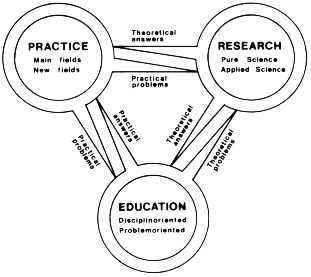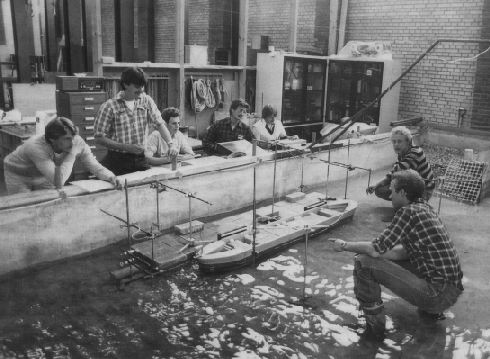

PROBLEM-ORIENTATION AS A LINK BETWEEN THE ACADEMIC AND THE PROFESSIONAL WORLDSBut who is to guard the guards themselves? Plato Once there had been a marvellous party among the Guards in ancient Athens. They got drunk, began to disturb law and order and get into combats with the citizens of Athens. But what were the citizens to do, since it was the persons who had been commissioned to keep law and order who disturbed it? This led Plato to the famous quotation "who is to guard the guards themselves?" In modern education we have a similar problem: "Who is to teach the teachers?". We have teachers who have been commissioned to train the next generation, but with the fast development of knowledge how can we be sure that teachers teach the students the latest knowledge in order to keep the graduates up-to-date? It is to this question the problem-oriented project work is an answer. In the old battle between those who think they possess knowledge - the sophists - and those who seek knowledge - the philosofists - problem-oriented project work stands besides Socrates and the other philosophers It is the attempt to solve the current problems within e.g. engineering which guides the students together with the teacher to the areas of knowledge and theories which are essential. At Aalborg University we have developed such a problem-oriented project-organized educational system which has operated successfully for the past twenty years. This book deals with a description of the system and our experience with it. PROFESSION, RESEARCH AND EDUCATIONThe educational system at Aalborg University was developed to ensure a dialectic relationship between academic theory and professional practice. This was to ensure greater adaptability of application between theory and practice for the purpose problem-solving. The theoretical problems make up the engine which operate this educational process and ensures that the knowledge of our graduates is up-to-date. A successful educational system depends on a comprehensive interplay between profession, research and education. The problems which are to be found in professional practice and research are the best guides for the learning process. They are the adhesives which bind practice, research and education together, and which make the result stronger than the single components.  Figure 1. The dynamic model of the relationships between practice, research and education. Practice may be defined as specific fields, or tasks, within society, conforming professional functions which are carried out by academically trained persons, e.g. civil engineers. In a society of increasing complexity, one has to continually face new problems and new challenges in practice. The technological development, computer integrated manufacturing, expert systems and genetic technologies are examples of these demands within our fields or within our practice. The specific tasks within the various professional functions are also changing and new areas are appearing. The traditional way in which to deal with these challenges is in-service training, professional seminars, the publication of articles, etc. This method of development is a slow process. The answers, or even the problems themselves, may no longer be of current relevance when the solutions are found, while society is still developing new problems which require new solutions. We have to face the fact that traditional methods are no longer always adequate. The answers are no longer to be found within the profession itself. In order to make improvements, we must involve research and education in the development process so that we get a dynamic interplay, as shown in Fig. 1. We need research to produce theoretical answers, and we need an interplay with education in order to produce graduates who are capable of producing practical answers, by applying new knowledge and skills to deal with the new and yet unknown problems of the future. APPLIED SCIENCEApplied Science deals with problems arising from practice. Applied Science is characterized by the imperative of the problem, i.e. the problems in which Applied Science can be involved are those which can be observed in the "real world" which lies outside the world of Pure Science. Applied Science is problem-oriented. The problem-oriented scientific process can be described as shown in Figure 2. As a basis for an attempt to attain a conscious perception we have a number of impressions, assumptions and theories built into our language, culture, professional practice and way of life. It is those impressions, assumptions and theories which guide us in our professional lives, but we can meet situations in which they are inadequate, and then practical problems can arise. The practical problem can be a symptom that something is wrong with our theories and assumptions, and thus the practical problem produces a theoretical problem as to why there is a practical problem (Adolphsen 1985). 
The causes of the problems which are experienced in practice outside the world of Pure Science, must be sought by means of Applied Science. The theories and methods best suited to give a scientific explanation are chosen from among all available scientific theories and methods. There are no cognitive, theoretical or methodological reasons to limit the choice of theories and methods in the problem-oriented research process. The solution to a theoretical problem is a new theory which explains the problem. If the theoretical explanation of the causes of the practical problem can provide a solution to it, there is strong evidence that the theory is valid. Thus it is possible to compare theories according to their ability to solve practical problems. What is described is the dynamic interplay between practice and research, where practice produces practical problems (inter alia) and research produces theoretical possibilities and answers; i.e. they produce new knowledge. Whereas Applied Science is influenced by the restriction to the problems which are recognized in practice outside the scientific world, and by the freedom to choose which theories and methods will be applied to solve the problems in question (Kjersdam 1987), Pure Science is, in contrast, influenced by the restraints of the paradigm on the choice of theory and method by the researcher, and by the licence of academic research, to choose to which of the puzzles of the paradigm a solution should be attempted (Kuhn 1962). Where as Applied Science pursues the systematic study of theoretical problems which originate outside the scientific world, Pure Science pursues systematic testing of the extent of the validity of theories and methods (Great Science) and operates in the realms of reality and abstraction, searching for new paradigms (Grand Science). It is in this dialectic interplay between Applied and Pure Science that scientific progress is achieved. This is where Applied Science compels the development of Pure Science to progress within areas in which practical problems exist, which cannot be explained within the existing assemblage of theories and methods. As a result, Applied Science develops by having new theoretical and methodological possibilities which are offered by steps forward in Pure Science. The comprehensive dynamic interplay, extending from the experience of practical problems to the discovery of new paradigms, and which forms the basis of scientific progress, is shown in Figure 3. EDUCATIONAL INNOVATIONThis scientific interplay constantly produces new paradigms, new theoretical possibilities, new theoretical explanations and new practical solutions, but it often takes many years to achive the innovation of these new inventions. Therefore, if we want to produce graduates with relevant qualifications and experience with the problems they will be expected to deal with after leaving the University, it is necessary that the faculty is composed by active researchers. If we socialize the students in an outdated paradigm, it will take many years, to alter their methods of working after graduation, if this is possible at all. This indicates the need for integration between education and research. To pursue this aim, it is essential to have a curriculum which has great internal adaptability in an innovative form. The curriculum must be quickly changeable to make it possible always to be able to deal with professional problems and their current implications to society. The internal adaptability of the curriculum makes it possible to test partial results from research from the faculty or elsewhere, without delay, in education, which should provide valuable feed-back for further research. We also have the possibility of dealing with theoretical problems in education by trying to solve the problems during the process of integration of education and research. Traditionally higher education has been focused on rule-based disciplines with independent identities in their own contexts. In the discipline-oriented education, the special disciplines and theories, which are considered necessary/relevant for the specific subjects, are taught by means of set textbooks and lectures. The students become experienced in the use of these disciplines and theories through the exercises and case work which support these theories. The aim is specific knowledge in certain fields and standard solutions to known problems. In this tradition all undergraduates in the same study programme follow virtually the same curriculum and - hopefully - acquire the necessary and sufficient knowledge in order to carry out certain specific functions in society. This system functions reasonably well in a stable society where the individual functions and tasks are reasonably standardized and where there is no awareness that the situation should be otherwise. Problem-oriented education, however, is based on working with unsolved, relevant and current problems from society/real life, e.g. the engineers' professional activity in an environment where solutions to real problems are sought. By analyzing the problems in depth the students learn and use the disciplines and theories which are considered to be necessary to solve the problems posed, i.e. the problem defines the subjects and not the reverse. Organizing problem-oriented education as project work allows groups of students to choose problems and work with them, learning from each other. The individual student - hopefully - acquires the necessary basic knowledge and information by means of literature and lectures and, through project work, develops the ability to formulate, analyze and solve relevant problems. In principle, it can thus be ensured that the graduates have obtained the experience to enable them to solve also the unenvisaged problems of the future. How educational progress is to be achieved will now depend on the degree of awareness of the necessary dialectics between discipline and problem-oriented education. The disciplines and their related theories are necessary for the graduates' fundamental academic knowledge, and they are needed in order to provide basic professional knowledge for the project work. On the other hand, problem-oriented project work is necessary in order to understand the inter-disciplinary interplay existing in the problems of real life, and to enable the graduates to deal with the new and unknown problems which will appear in the future. The aim is a broad insight into and understanding of the connections between different fields and skills, in order to be able to function in an ever-changing society, which is becomming increasingly more complicated. The problem-oriented educational system involves professional problems as they appear in real life. The process from when a problem appears in practice and until the theoretical and practical answer are found and implemented in practice takes time. If we wish to increase the speed of this process, the students have to be provided with great external adaptability, in an innovative form. This means that the graduates must be in possession of comprehensive knowledge of the development of theoretical and methodological tools in order to solve new and complex problems which will appear in the future. The graduates must be able to cope with the structural changes within the existing professional fields and, perhaps, to form new areas of practice.
|